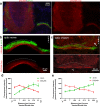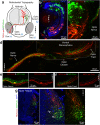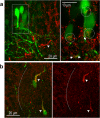DSCAM is differentially patterned along the optic axon pathway in the developing Xenopus visual system and guides axon termination at the target
- PMID: 35422013
- PMCID: PMC9011933
- DOI: 10.1186/s13064-022-00161-9
DSCAM is differentially patterned along the optic axon pathway in the developing Xenopus visual system and guides axon termination at the target
Abstract
Background: The Xenopus retinotectal circuit is organized topographically, where the dorsal-ventral axis of the retina maps respectively on to the ventral-dorsal axis of the tectum; axons from the nasal-temporal axis of the retina project respectively to the caudal-rostral axis of the tectum. Studies throughout the last two decades have shown that mechanisms involving molecular recognition of proper termination domains are at work guiding topographic organization. Such studies have shown that graded distribution of molecular cues is important for topographic mapping. However, the complement of molecular cues organizing topography along the developing optic nerve, and as retinal axons cross the chiasm and navigate towards and innervate their target in the tectum, remains unknown. Down syndrome cell adhesion molecule (DSCAM) has been characterized as a key molecule in axon guidance, making it a strong candidate involved in the topographic organization of retinal fibers along the optic path and at their target.
Methods: Using a combination of whole-brain clearing and immunohistochemistry staining techniques we characterized DSCAM expression and the projection of ventral and dorsal retinal fibers starting from the eye, following to the optic nerve and chiasm, and into the terminal target in the optic tectum in Xenopus laevis tadpoles. We then assessed the effects of DSCAM on the establishment of retinotopic maps through spatially and temporally targeted DSCAM knockdown on retinal ganglion cells (RGCs) with axons innervating the optic tectum.
Results: Highest expression of DSCAM was localized to the ventral posterior region of the optic nerve and chiasm; this expression pattern coincides with ventral fibers derived from ventral RGCs. Targeted downregulation of DSCAM expression on ventral RGCs affected the segregation of medial axon fibers from their dorsal counterparts within the tectal neuropil, indicating that DSCAM plays a role in retinotopic organization.
Conclusion: These findings together with previous studies demonstrating cell-autonomous roles for DSCAM during the development of pre- and postsynaptic arbors in the Xenopus retinotectal circuit indicates that DSCAM exerts multiple roles in coordinating axon targeting and structural connectivity in the developing vertebrate visual system.
Keywords: Axon targeting; DSCAM; In vivo imaging; Optic nerve; Optic tectum; Retina; Retinal ganglion cell; Xenopus laevis.
© 2022. The Author(s).
Conflict of interest statement
The authors declare that they have no competing interests.
Figures







Similar articles
-
DSCAM differentially modulates pre- and postsynaptic structural and functional central connectivity during visual system wiring.Neural Dev. 2018 Sep 15;13(1):22. doi: 10.1186/s13064-018-0118-5. Neural Dev. 2018. PMID: 30219101 Free PMC article.
-
EphA3 expressed in the chicken tectum stimulates nasal retinal ganglion cell axon growth and is required for retinotectal topographic map formation.PLoS One. 2012;7(6):e38566. doi: 10.1371/journal.pone.0038566. Epub 2012 Jun 7. PLoS One. 2012. PMID: 22685584 Free PMC article.
-
Inaccuracies in initial growth and arborization of chick retinotectal axons followed by course corrections and axon remodeling to develop topographic order.J Neurosci. 1989 Nov;9(11):3776-95. doi: 10.1523/JNEUROSCI.09-11-03776.1989. J Neurosci. 1989. PMID: 2585055 Free PMC article.
-
The multiple decisions made by growth cones of RGCs as they navigate from the retina to the tectum in Xenopus embryos.J Neurobiol. 2000 Aug;44(2):246-59. J Neurobiol. 2000. PMID: 10934326 Review.
-
New views on retinal axon development: a navigation guide.Int J Dev Biol. 2004;48(8-9):957-64. doi: 10.1387/ijdb.041899fm. Int J Dev Biol. 2004. PMID: 15558486 Free PMC article. Review.
Cited by
-
Exploring perspectives of Dscam for cognitive deficits: a review of multifunction for regulating neural wiring in homeostasis.Front Mol Neurosci. 2025 May 2;18:1575348. doi: 10.3389/fnmol.2025.1575348. eCollection 2025. Front Mol Neurosci. 2025. PMID: 40385132 Free PMC article. Review.
-
Oligodendrocyte arrangement, identification and morphology in the developing superior olivary complex.Front Cell Neurosci. 2025 Mar 28;19:1561312. doi: 10.3389/fncel.2025.1561312. eCollection 2025. Front Cell Neurosci. 2025. PMID: 40226299 Free PMC article.

